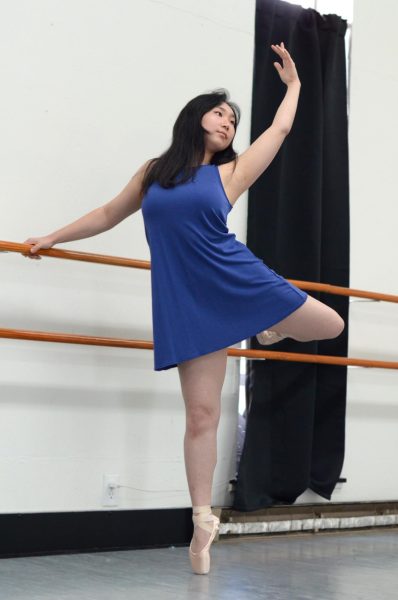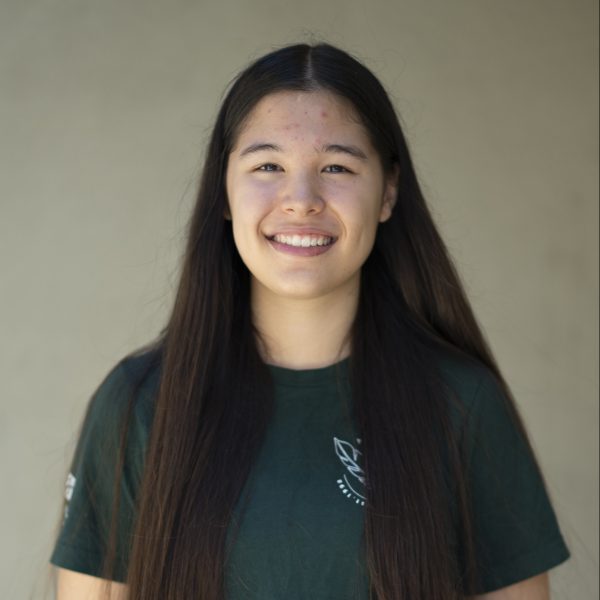
History may be written by the victors, but Mina Okamoto (12) looks beyond the surface level of history, diving deeper into the untold stories and policies that historically shaped women and their identities. Through the process of this research, she learned to come to terms with her own relationship to femininity. In her historical endeavors and beyond, Mina is an advocate for others around her, from her dance students to her friends to capoeira classmates.
Mina attributes her interest in feminist history to her mother, who graduated from a women’s college and instilled these principles in her. Despite this upbringing, Mina struggled with her own perception of femininity and being able to accept her more feminine side.
“I think my relationship with femininity and gender is very strange,” Mina said. “For a long time, I really played into that ‘not like other girls’ kind of thing, where it was better being non-traditionally feminine and interested in more masculine things. For me, a lot of my journey has been reversing that and understanding what it means to me to be a woman.”
Mina reconnected with her femininity at the Gender Sexuality Alliance meetings by learning from positive role models who helped build her confidence. By exploring her internal relationship with her gender and confronting others’ perception of her, Mina came to a better understanding of her identity.
“Part of reconnecting to what it means to be a woman and to have shared experiences with other people like me has been a lot about my gender expression,” Mina said. “How I present, how I talk about my interests, who I hang out with, the kind of music I like. It’s been a lot of really questioning what I do like, and what things really interests me versus what I want to look like to other people.”
At the end of junior year, Mina blended her interests in gender studies and history in her Near project, which examines the Chamberlain-Kahn Act’s legal and social impacts on women in the early 1900s.
The 1918 Chamberlain-Kahn Act allowed the United States government to quarantine any woman suspected of carrying a sexually transmitted disease. Mina’s research mentor and upper school history teacher Chris Gatto values her dedication to her project and her commitment to the history of her topic.
“She’s very excited and enthusiastic about her project and about history,” Gatto said. “She’d done a lot of her research beforehand. She’s very thoughtful and focused and very determined to accomplish a lot in the upcoming year.”
Mina started dancing when she was two years old and continued with competitive dance for many years. After taking a break from dance competitions for a year, Mina struggled to find her place at her dance company. When she started back at the company as an assistant teacher for younger students, she discovered a newfound appreciation for dance inspired by her perspective as an instructor.
“Getting to see it from a teaching side really made me appreciate all the hard work that goes into the classes and that my teachers really cared about me,” Mina said. “For me, teaching is more than just teaching kids how to play and how to saute. I really like to get to know the kids; I like to get to know how to make the different kids laugh. It’s really rewarding to get to have that connection to the students.”
Mina’s supportiveness and helpful personality allow her to form an easygoing rapport with her students at the dance studio and friends at school. Close friend Catherine Wong (12) treasures Mina’s vibrant sense of humor and caring nature.
“I wish I had more classes with her because she livens up any class I have with her,” Catherine said. “She’s always very friendly and welcoming to basically everyone around her.”
In her capoeira classes at Harker, Mina encourages and supports newer students to help them adjust to the unique challenges of Brazilian martial arts. Close friend Claire Perng (11) met Mina through Harker’s capoeira classes and quickly grew to value Mina’s caring presence toward younger students.
“She’s a good teacher and mentor figure, and she helps out at her dance place,” Claire said. “Of course in capoeira, the teacher has us help demonstrate different techniques, and she works with new people and helps them learn how to do different things.”
In her gender expression and in dance, Mina prioritizes her happiness and sense of individuality over the judgment of others, and rediscovering her identity allowed her to rekindle enthusiasm for her activities. Through her interactions with her friends or students, she seeks to help others similarly find joy and humanity in their interests.
“I used to care a lot more about being respected rather than being known as a person with the things I’ve gotten to do: spending time with my students at dance, getting through this research project,” Mina said. “Letting people see who I am, what I’m interested in — that’s become more important to me, than being some kind of a bot just working. I think I care more about the human side of things now.”


















![“[Building nerf blasters] became this outlet of creativity for me that hasn't been matched by anything else. The process [of] making a build complete to your desire is such a painstakingly difficult process, but I've had to learn from [the skills needed from] soldering to proper painting. There's so many different options for everything, if you think about it, it exists. The best part is [that] if it doesn't exist, you can build it yourself," Ishaan Parate said.](https://harkeraquila.com/wp-content/uploads/2022/08/DSC_8149-900x604.jpg)




![“When I came into high school, I was ready to be a follower. But DECA was a game changer for me. It helped me overcome my fear of public speaking, and it's played such a major role in who I've become today. To be able to successfully lead a chapter of 150 students, an officer team and be one of the upperclassmen I once really admired is something I'm [really] proud of,” Anvitha Tummala ('21) said.](https://harkeraquila.com/wp-content/uploads/2021/07/Screen-Shot-2021-07-25-at-9.50.05-AM-900x594.png)







![“I think getting up in the morning and having a sense of purpose [is exciting]. I think without a certain amount of drive, life is kind of obsolete and mundane, and I think having that every single day is what makes each day unique and kind of makes life exciting,” Neymika Jain (12) said.](https://harkeraquila.com/wp-content/uploads/2017/06/Screen-Shot-2017-06-03-at-4.54.16-PM.png)








![“My slogan is ‘slow feet, don’t eat, and I’m hungry.’ You need to run fast to get where you are–you aren't going to get those championships if you aren't fast,” Angel Cervantes (12) said. “I want to do well in school on my tests and in track and win championships for my team. I live by that, [and] I can do that anywhere: in the classroom or on the field.”](https://harkeraquila.com/wp-content/uploads/2018/06/DSC5146-900x601.jpg)
![“[Volleyball has] taught me how to fall correctly, and another thing it taught is that you don’t have to be the best at something to be good at it. If you just hit the ball in a smart way, then it still scores points and you’re good at it. You could be a background player and still make a much bigger impact on the team than you would think,” Anya Gert (’20) said.](https://harkeraquila.com/wp-content/uploads/2020/06/AnnaGert_JinTuan_HoHPhotoEdited-600x900.jpeg)

![“I'm not nearly there yet, but [my confidence has] definitely been getting better since I was pretty shy and timid coming into Harker my freshman year. I know that there's a lot of people that are really confident in what they do, and I really admire them. Everyone's so driven and that has really pushed me to kind of try to find my own place in high school and be more confident,” Alyssa Huang (’20) said.](https://harkeraquila.com/wp-content/uploads/2020/06/AlyssaHuang_EmilyChen_HoHPhoto-900x749.jpeg)



